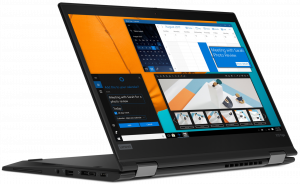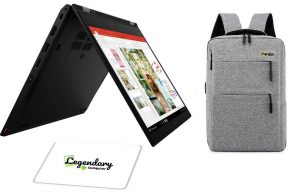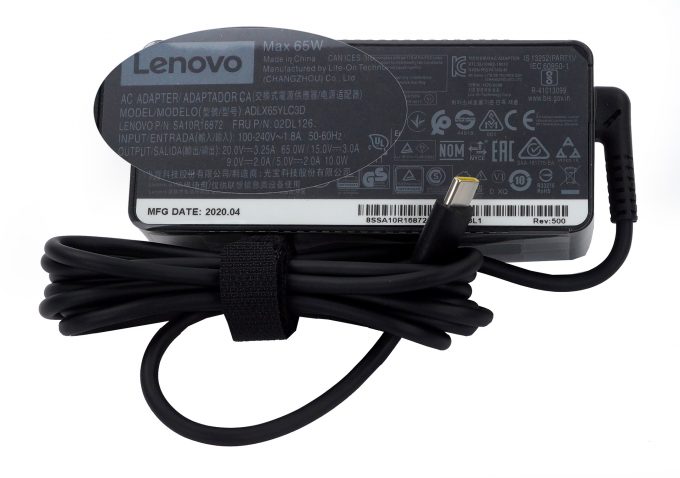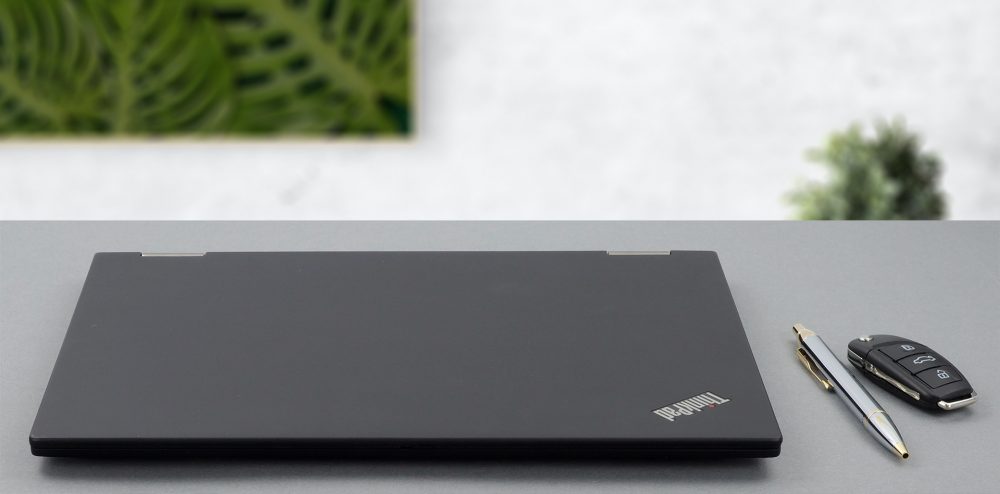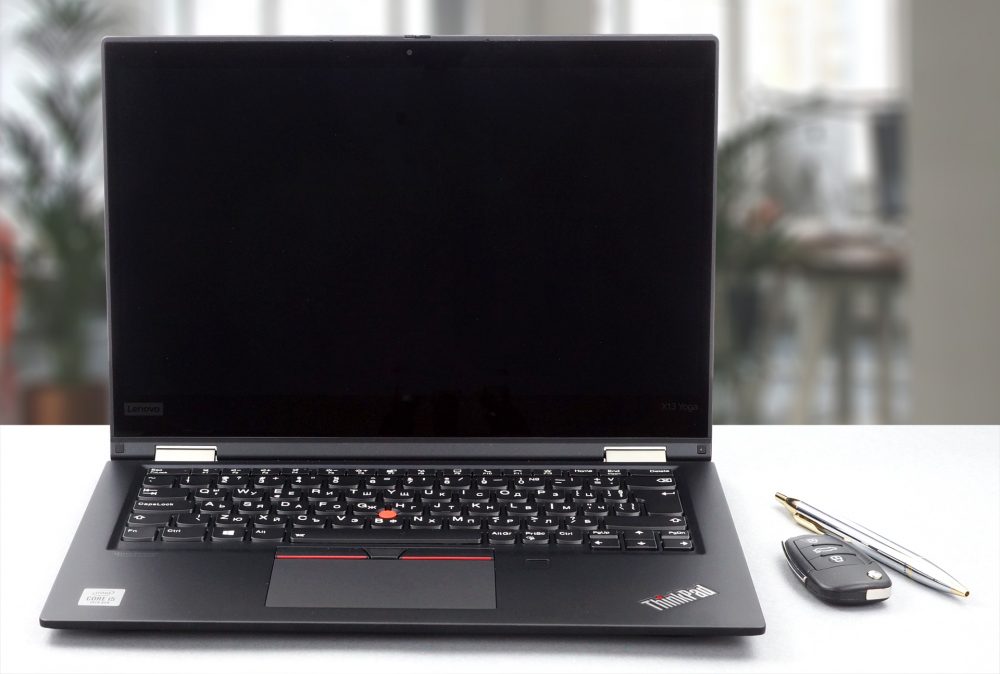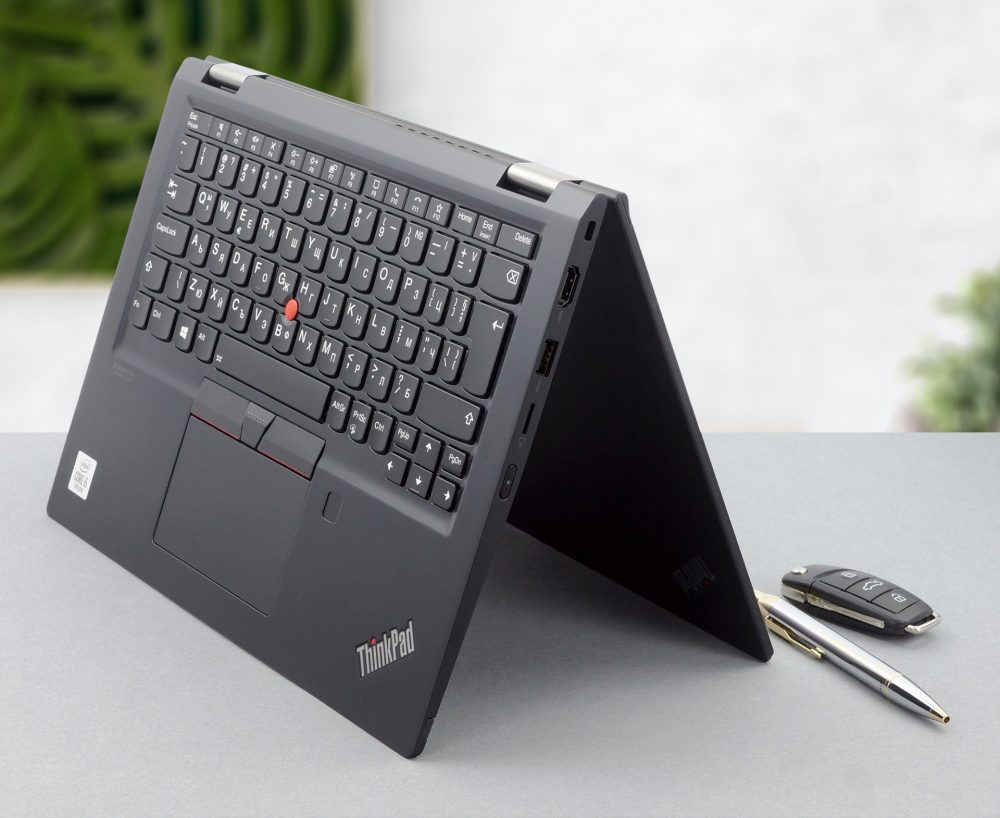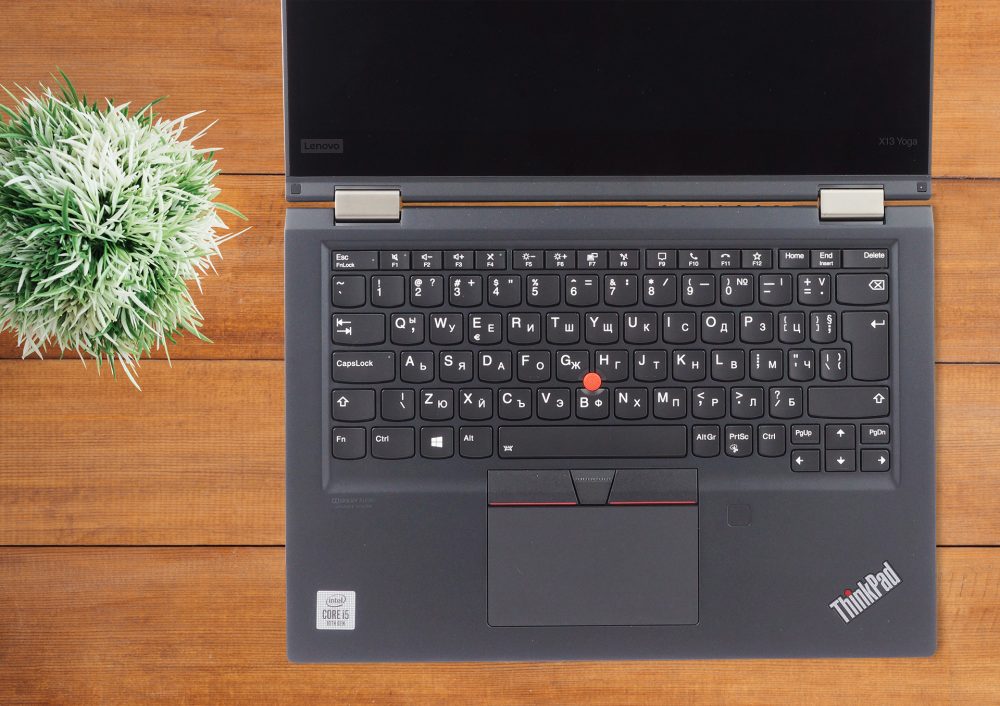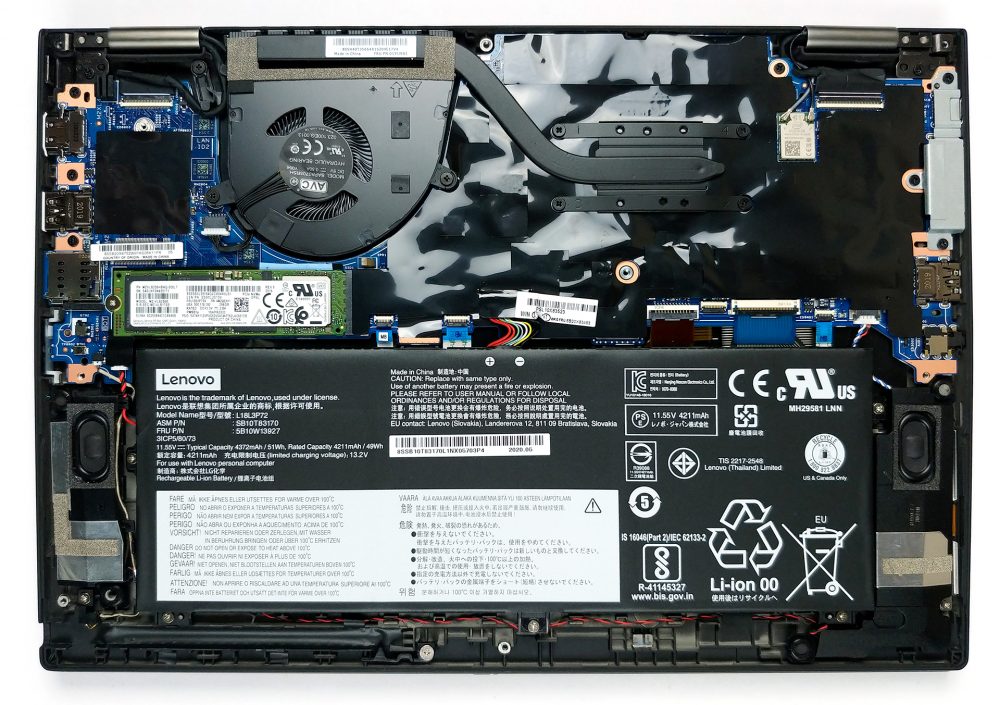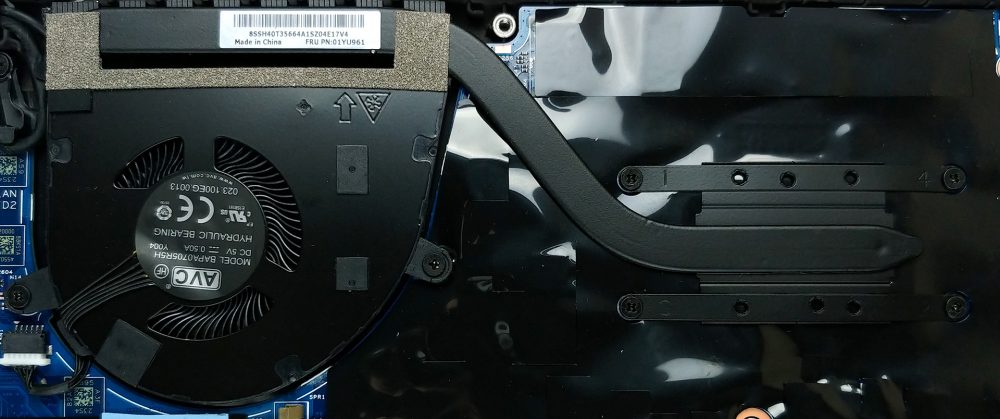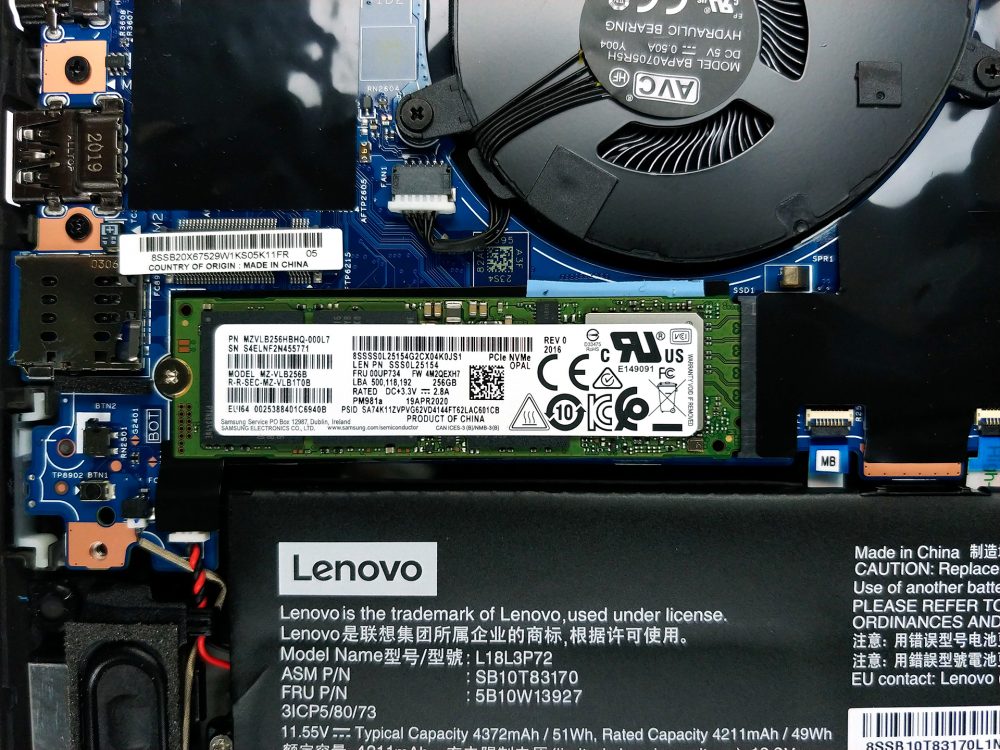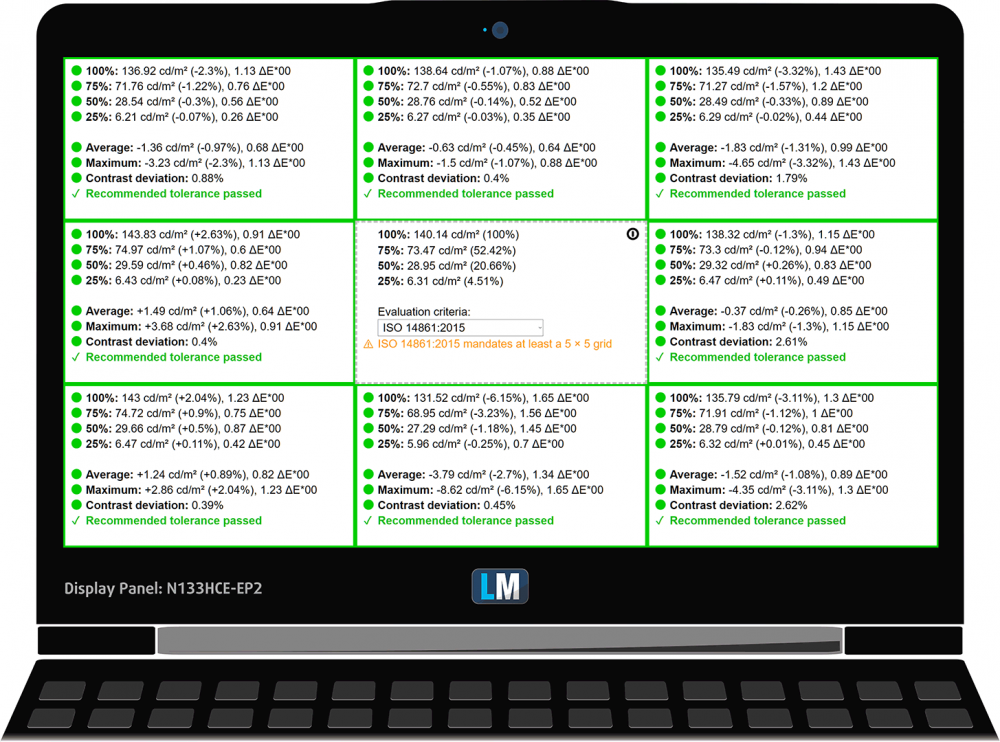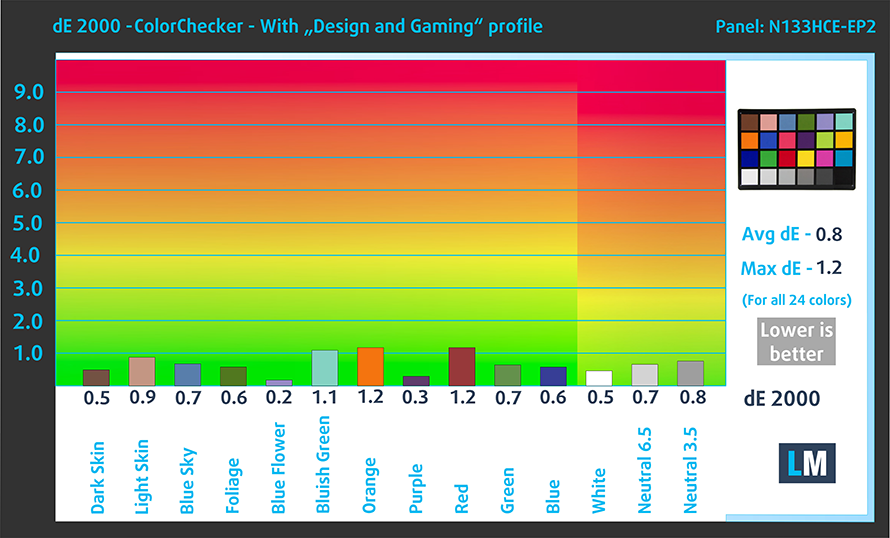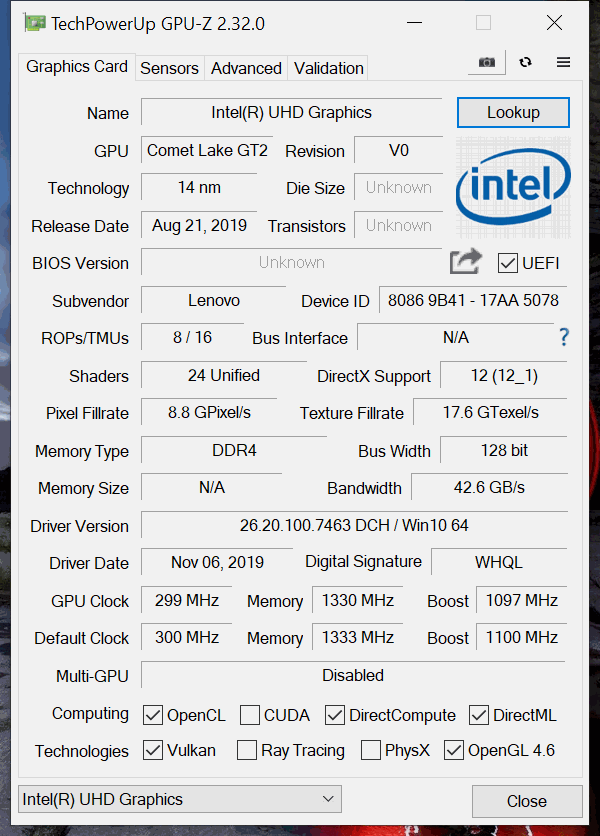Lenovo ThinkPad X13 Yoga review – a business laptop with accurate colors and a lot of ports
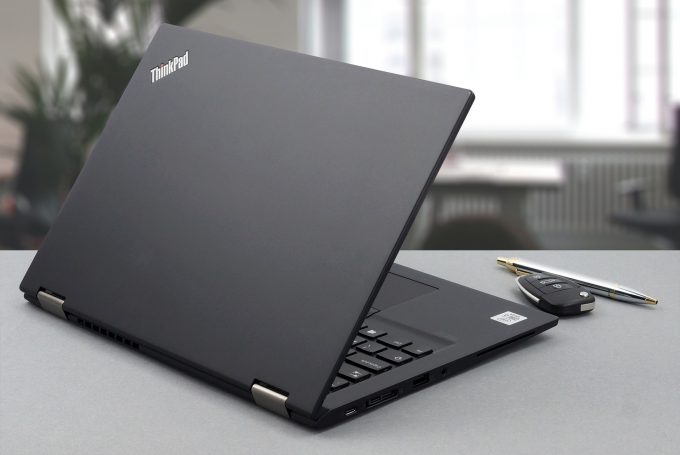 Having a business laptop is not a limiting factor no more. With the ThinkPads becoming thinner and lighter, and the Yoga series bringing more security and versatility, Lenovo started marrying the two lineups into one. This is how the ThinkPad Yoga was born. And although the X1 Carbon is their top line, the ThinkPad X13 Yoga is also a device that brings premium features to the table.
Having a business laptop is not a limiting factor no more. With the ThinkPads becoming thinner and lighter, and the Yoga series bringing more security and versatility, Lenovo started marrying the two lineups into one. This is how the ThinkPad Yoga was born. And although the X1 Carbon is their top line, the ThinkPad X13 Yoga is also a device that brings premium features to the table.
This includes an included stylus, optional 4K OLED display, and very wide I/O support, including a Thunderbolt 3 connector, MicroSD card slot, an optional SIM card tray, and more.
Unsurprisingly, though, they are still relying on the 14nm Comet Lake-U processors. This may be because of a number of reasons, but the most prominent one would be the vPro support of the former.
So, it is very interesting how its display performs, because if it is able to show accurate-enough color representation, it opens the door for quite a lot of professional and productivity scenarios. Sadly, we were not able to lay our hands on the 4K OLED model. Hence, we were left with the 1080p unit, which nonetheless should provide a wide-enough color-gamut, according to Lenovo.
You can check the prices and configurations in our Specs System: https://laptopmedia.com/series/lenovo-thinkpad-x13-yoga-gen-1/
Contents
Top 5 Reasons to BUY or not BUY the X13 Yoga
Specs Sheet
- HDD/SSD
- fino a 2000GB SSD
- Slot M.2
- 1x 2280 PCIe NVMe 3.0 x4 Vedi foto
- RAM
- up to 16GB
- OS
- Windows 11 Pro, Windows 10 Pro, Windows 10 Home
- Batteria
- 50Wh, 50Wh, 3-cell, 80Wh, 4-cell
- Materiale del corpo
- Plastic / Polycarbonate, Carbon, Glass Fiber, Magnesium alloy
- Dimensioni
- 310.4 x 219 x 15.9 mm (12.22" x 8.62" x 0.63")
- Peso
- 1.25 kg (2.8 lbs)
- Porte e connettività
- 2x USB Type-A
- 3.2 Gen 2 (10 Gbps)
- 1x USB Type-C
- 3.2 Gen 1 (5 Gbps), Power Delivery (PD), DisplayPort
- 1x USB Type-C
- 3.2 Gen 2 (10 Gbps), Thunderbolt 3, Power Delivery (PD), DisplayPort
- HDMI
- 1.4b
- Lettore di schede
- MicroSD
- Wi-Fi
- 802.11ax
- Bluetooth
- 5.0
- Jack audio
- 3.5 mm combo
- Docking Connector
- Caratteristiche
- Lettore di impronte digitali
- optional
- Telecamera web
- HD and IR
- Tastiera retroilluminata
- optional
- Microfono
- Dual Array Far-field Microphone
- Altoparlanti
- 2x 2W, Dolby Audio
- Unità ottica
- Fessura del blocco di sicurezza
Tutti Lenovo ThinkPad X13 Yoga Gen 1 configurazioni
What’s in the box?
Inside the package, we found some paper manuals, as well as a 65W USB Type-C power brick.
Design and construction
The portability here is great – the profile stands at only 15.95mm, while the weight is 1.25 kg. This is achieved thanks to the complicated materials used in this build. Both the bottom panel and the lid cover are built from Carbon fiber hybrid polymer plus 55% glass fiber content. Also, the chassis is made out of magnesium, which actually makes the structure a lot stiffer than its weight suggests.
Unfortunately, but not unexpectedly, the lid can’t be opened with a single hand. However, the hinges allow for a 360° movement of the display. And on the downside, it is a bit bendy, and the top and bottom bezel are absolutely huge. As a consolation, the top one holds not only an HD camera with a privacy shutter, but it also houses an IR sensor for face recognition.
Another feature of this display is its ability to interact with a stylus. And thankfully, Lenovo has included one, as it has its own spot inside the chassis of the machine. It works immediately out of the box and doesn’t require any pairing or installation. Also, it is pretty nimble and accurate, but its small size can be slightly uncomfortable for long periods of use.
Next, we have the keyboard. And this is the one place where Lenovo doesn’t let down, no matter the ThinkPad we’re talking about. It has a long travel, clicky, yet quiet feedback, and a backlight. Also, it is spill-resistant and has the proprietory Red Nipple.
The Nipple, itself, works in conjunction with the trio of buttons above the touchpad. Speaking of which, it has the typical buttonless Mylar setup, and while it is generally decent for most things you would do, we are not big fans of the matte finish, which hinders the gliding properties, and will most likely wear off, leaving a scar on the laptop’s premium base.
When you turn the laptop upside down, you will only see the small ventilation grills, as well as the speaker cutouts. In contrast to most notebooks from the ThinkPad family, this one exhausts its hot air from the back.
Ports
A very prominent feature of this business convertible is its I/O. On the left side, you will find one USB Type-C 3.2 (Gen. 1) port, used for charging, and DisplayPort output, followed by a Thunderbolt 3 port, with the same capabilities, but significantly higher bandwidth, compared to the previous Type-C port. Then, there is an Ethernet extension connector, an Always-on USB Type-A 3.2 (Gen. 1) port, an audio jack, and an optional Smart Card reader. Switching to the right, we see a security wedge hole, an HDMI 1.4b connector, another USB Type-A 3.2 (Gen. 1) port, a MicroSD card reader, and the Power button. Also, here, you will find the dedicated stylus that comes with the laptop. Optionally, you will have a nano-SIM card tray.
Disassembly, upgrade options, and maintenance
The bottom panel of this device is held in place by 8 captive Phillips-head screws. After you undo them, remove the stylus from its tray and pry the panel with a plastic tool.
Inside, we see a traditional cooling setup, that includes a single heat pipe, a heat sink, and a medium-sized fan.
Sadly, there is no option for memory upgrades, as all of the memory chips are soldered to the motherboard. That said, this model can be configured with 8 or 16GB of DDR4 RAM, working at 2666MHz. At least, there is the relief you can put a larger or faster SSD in the form of an M.2 PCIe x4 drive.
As far as the battery capacity goes, Lenovo has put a 51Wh unit inside of the Thinkpad X13 Yoga.
Display quality
Lenovo ThinkPad X13 Yoga has a Full HD IPS panel, Innolux N133HCE-EP2. Its diagonal is 13.3-inch (33.78 cm), and the resolution – 1920 х 1080p. Additionally, the screen ratio is 16:9, the pixel density – 166 ppi, their pitch – 0.153 х 0.153 mm. The screen can be considered Retina when viewed from at least 53 cm (from this distance, the average human eye can’t see the individual pixels).
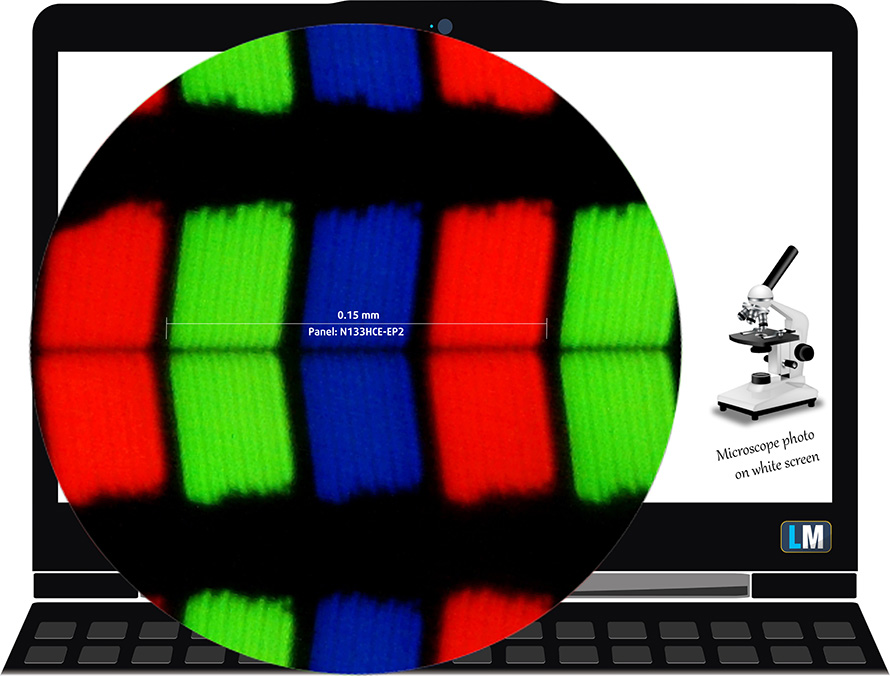
Its viewing angles are comfortable. We offer images at different angles to evaluate the quality.

The maximum measured brightness is 302 nits (cd/m2) in the middle of the screen and 298 nits (cd/m2) average across the surface with a maximum deviation of 6%. The Correlated Color Temperature on a white screen and at maximum brightness is 6860K – slightly colder than the 6500K temperature for sRGB.
In the illustration below you can see how the display performs from a uniformity perspective. The illustration below shows how matters are for operational brightness levels (approximately 140 nits) – in this particular case at 73% Brightness (White level = 140 cd/m2, Black level = 0.13 cd/m2).
Values of dE2000 over 4.0 should not occur, and this parameter is one of the first you should check if you intend to use the laptop for color-sensitive work (a maximum tolerance of 2.0 ). The contrast ratio is good – 1060:1.
To make sure we are on the same page, we would like to give you a little introduction to the sRGB color gamut and the Adobe RGB. To start, there’s the CIE 1976 Uniform Chromaticity Diagram that represents the visible specter of colors by the human eye, giving you a better perception of the color gamut coverage and the color accuracy.
Inside the black triangle, you will see the standard color gamut (sRGB) that is being used by millions of people on HDTV and on the web. As for the Adobe RGB, this is used in professional cameras, monitors, etc for printing. Basically, colors inside the black triangle are used by everyone and this is the essential part of the color quality and color accuracy of a mainstream notebook.
Still, we’ve included other color spaces like the famous DCI-P3 standard used by movie studios, as well as the digital UHD Rec.2020 standard. Rec.2020, however, is still a thing of the future and it’s difficult for today’s displays to cover that well. We’ve also included the so-called Michael Pointer gamut, or Pointer’s gamut, which represents the colors that naturally occur around us every day.
The yellow dotted line shows Lenovo ThinkPad X13 Yoga’s color gamut coverage.
Its display covers 98% of the sRGB/ITU-R BT.709 (web/HDTV standard) in CIE1976, which is a prerequisite for a punchy image.
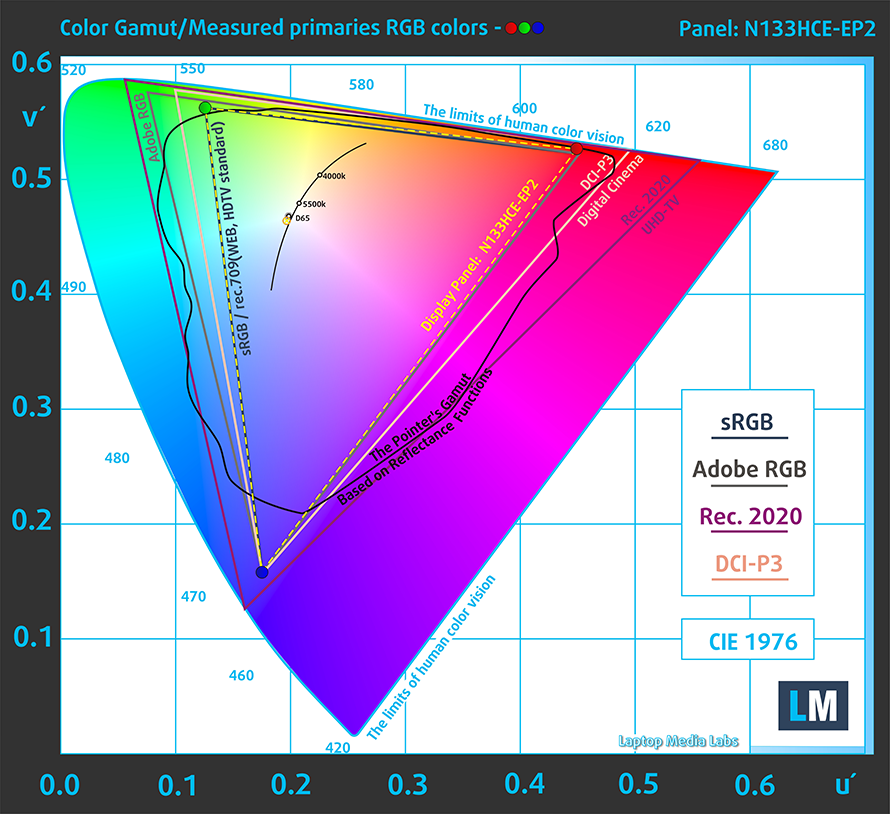
Our “Design and Gaming” profile delivers optimal color temperature (6500K) at 140 cd/m2 luminance and sRGB gamma mode.
We tested the accuracy of the display with 24 commonly used colors like light and dark human skin, blue sky, green grass, orange, etc. You can check out the results at factory condition and also, with the “Design and Gaming” profile.
Below you can compare the scores of Lenovo ThinkPad X13 Yoga with the default settings (left), and with the “Gaming and Web design” profile (right).
The next figure shows how well the display is able to reproduce really dark parts of an image, which is essential when watching movies or playing games in low ambient light.
The left side of the image represents the display with stock settings, while the right one is with the “Gaming and Web Design” profile activated. On the horizontal axis, you will find the grayscale, and on the vertical axis – the luminance of the display. On the two graphs below you can easily check for yourself how your display handles the darkest nuances but keep in mind that this also depends on the settings of your current display, the calibration, the viewing angle, and the surrounding light conditions.
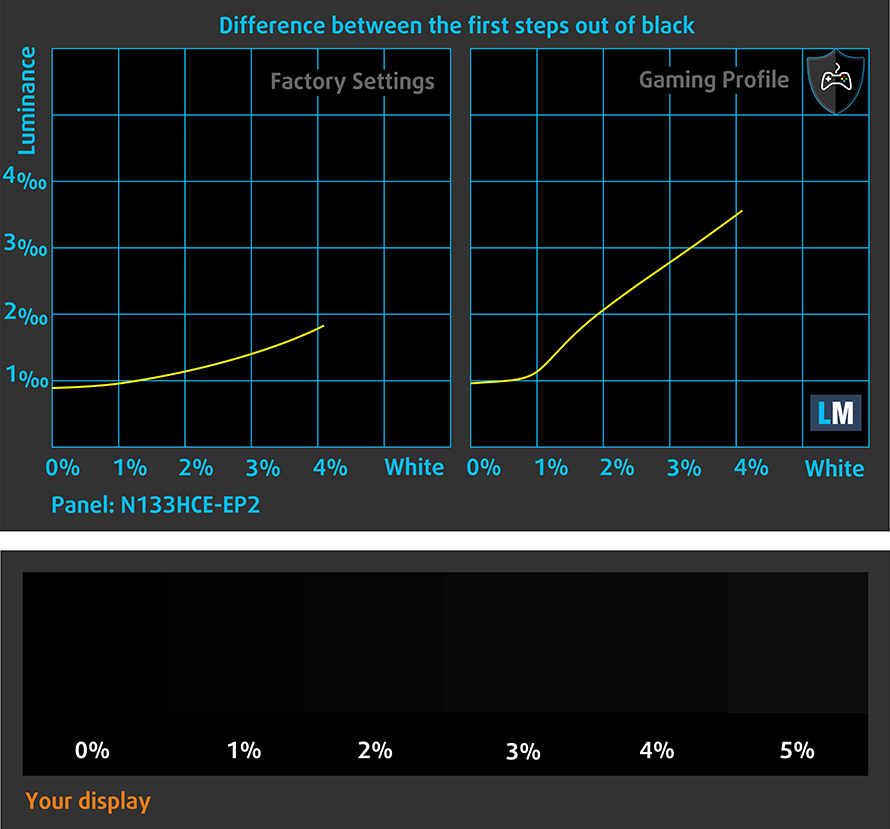
Response time (Gaming capabilities)
We test the reaction time of the pixels with the usual “black-to-white” and “white-to-black” method from 10% to 90% and vice versa.
We recorded Fall Time + Rise Time = 29 ms
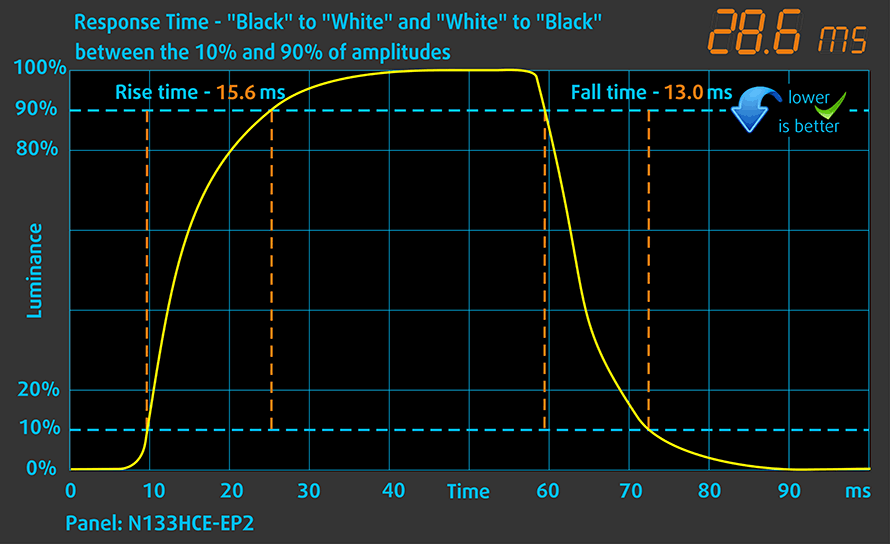
Health impact – PWM / Blue Light
PWM (Screen flickering)
Pulse-width modulation (PWM) is an easy way to control monitor brightness. When you lower the brightness, the light intensity of the backlight is not lowered, but instead turned off and on by the electronics with a frequency indistinguishable to the human eye. In these light impulses, the light/no-light time ratio varies, while brightness remains unchanged, which is harmful to your eyes. You can read more about that in our dedicated article on PWM.
Lenovo ThinkPad X13 Yoga’s backlight uses PWM for brightness adjustment up to 78 nits and with a very high frequency, which makes it comfortable for long periods of use in this aspect.

Blue light emissions
Installing our Health-Guard profile not only eliminates PWM but also reduces the harmful Blue Light emissions while keeping the colors of the screen perceptually accurate. If you’re not familiar with the Blue light, the TL;DR version is – emissions that negatively affect your eyes, skin, and your whole body. You can find more information about that in our dedicated article on Blue Light.
Conclusion
Lenovo ThinkPad X13 Yoga’s IPS panel has a Full HD resolution, good contrast ratio, and comfortable viewing angles. It also covers 98% of the sRGB color gamut and its backlight doesn’t flicker above 78 nits (below that the frequency is very high and hardly detectable). Moreover, this unit has a very high color accuracy, especially with our Gaming and Web design profile, which is excellent for Web designers, e-commerce retailers, and presenters.
Buy our profiles
Since our profiles are tailored for each individual display model, this article and its respective profile package are meant for Lenovo ThinkPad X13 Yoga configurations with 13.3″ Innolux N133HCE-EP2 (FHD, 1920 × 1080) IPS panel.
*Should you have problems with downloading the purchased file, try using a different browser to open the link you’ll receive via e-mail. If the download target is a .php file instead of an archive, change the file extension to .zip or contact us at [email protected].
Read more about the profiles HERE.
Oltre a ricevere profili efficienti e rispettosi della salute, comprando i prodotti di LaptopMedia sostenete anche lo sviluppo dei nostri laboratori, dove testiamo i dispositivi per produrre le recensioni più obiettive possibili.

Lavoro in ufficio
Lavoro in ufficio dovrebbe essere usato soprattutto dagli utenti che passano la maggior parte del tempo a guardare pezzi di testo, tabelle o semplicemente a navigare. Questo profilo mira a fornire una migliore distinzione e chiarezza mantenendo una curva gamma piatta (2.20), una temperatura di colore nativa e colori percettivamente accurati.

Design e gioco
Questo profilo è rivolto ai designer che lavorano professionalmente con i colori, e anche per giochi e film. Design and Gaming porta i pannelli di visualizzazione ai loro limiti, rendendoli il più accurati possibile nello standard sRGB IEC61966-2-1 per Web e HDTV, al punto di bianco D65.

Salute-Guardia
Salute-Guardia elimina la nociva Pulse-Width Modulation (PWM) e riduce la luce blu negativa che colpisce i nostri occhi e il nostro corpo. Essendo personalizzato per ogni pannello, riesce a mantenere i colori percettivamente accurati. Salute-Guardia simula la carta, quindi la pressione sugli occhi è notevolmente ridotta.
Ottenete tutti e 3 i profili con il 33% di sconto
Sound
Lenovo ThinkPad X13 Yoga’s speakers produce a decent quality sound. Its maximum volume isn’t very high, and there are some deviations in the entire frequency spectrum.
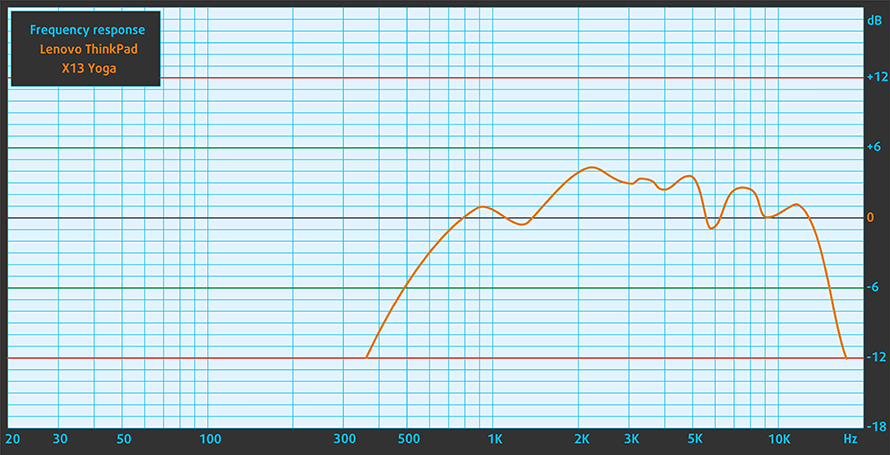
Drivers
All of the drivers and utilities for this notebook can be found here: https://pcsupport.lenovo.com/us/en/products/laptops-and-netbooks/thinkpad-x-series-laptops/thinkpad-x13-yoga-gen-1/downloads/driver-list
Battery
Now, we conduct the battery tests with Windows Better performance setting turned on, screen brightness adjusted to 120 nits, and all other programs turned off except for the one we are testing the notebook with. This notebook’s 51Wh unit lasts for 11 hours and 40 minutes of Web browsing and 11 hours and 29 minutes of video playback.
Per simulare le condizioni reali, abbiamo utilizzato un nostro script per la navigazione automatica su oltre 70 siti web.
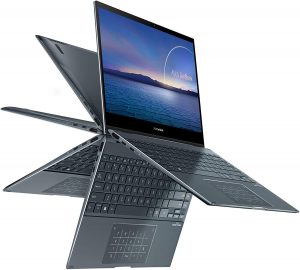

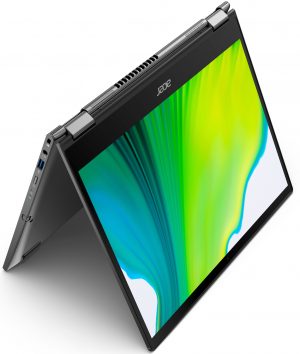
Per ogni test come questo, utilizziamo lo stesso video in HD.



CPU options
This laptop is equipped with Comet Lake-U processors, including the Core i5-10210U, Core i7-10510U, and their respective vPro versions – the Core i5-10310U, and Core i7-10610U, all of which are four-core/eight-thread CPUs.
I risultati provengono dal test CPU Cinebench 20 (più alto è il punteggio, meglio è)
I risultati provengono dal nostro test di Photoshop (più basso è il punteggio, meglio è)
GPU options
And since there is no dedicated GPU option, you only get the integrated Intel UHD Graphics.
I risultati provengono dal benchmark 3DMark: Time Spy (Graphics) (più alto è il punteggio, migliore è il risultato).
I risultati provengono dal benchmark 3DMark: Fire Strike (Grafica) (più alto è il punteggio, meglio è)
I risultati provengono dal benchmark Unigine Superposition (più alto è il punteggio, migliore è il risultato)
Gaming tests

| CS:GO | HD 1080p, Low (Check settings) | HD 1080p, Medium (Check settings) | HD 1080p, MAX (Check settings) |
|---|---|---|---|
| Average fps | 63 fps | 33 fps | – fps |

| DOTA 2 | HD 1080p, Low (Check settings) | HD 1080p, Normal (Check settings) | HD 1080p, High (Check settings) |
|---|---|---|---|
| Average fps | 73 fps | 37 fps | – fps |
Temperatures and comfort
Max CPU load
In this test we use 100% on the CPU cores, monitoring their frequencies and chip temperature. The first column shows a computer’s reaction to a short load (2-10 seconds), the second column simulates a serious task (between 15 and 30 seconds), and the third column is a good indicator of how good the laptop is for long loads such as video rendering.
Average core frequency (base frequency + X); CPU temp.
| Intel Core i5-10210U (15W TDP) | 0:02 – 0:10 sec | 0:15 – 0:30 sec | 10:00 – 15:00 min |
|---|---|---|---|
| Lenovo ThinkPad X13 Yoga | 3.03 GHz (B+89%) @ 97°C | 2.58 GHz (B+61%) @ 97°C | 2.20 GHz (B+38%) @ 97°C |
| HP EliteBook 840 G7 | 3.22 GHz (B+101%) @ 99°C | 2.06 GHz (B+29%) @ 79°C | 2.12 GHz (B+33%) @ 73°C |
| Lenovo ThinkPad L14 | 3.22 GHz (B+101%) @ 94°C | 2.95 GHz (B+84%) @ 97°C | 2.37 GHz (B+48%) @ 91°C |
| Lenovo ThinkPad X13 | 2.59 GHz (B+62%) @ 75°C | 1.84 GHz (B+15%) @ 74°C | 1.54 GHz @ 67°C |
| MSI Modern 14 | 2.33 GHz (B+46%) @ 61°C | 2.32 GHz (B+45%) @ 71°C | 2.07 GHz (B+29%) @ 80°C |
| HP Probook 440 G7 | 2.68 GHz (B+68%) @ 59°C | 2.68 GHz (B+68%) @ 67°C | 2.20 GHz (B+38%) @ 72°C |
| Lenovo ThinkBook 15-IML | 3.08 GHz (B+93%) @ 73°C | 3.00 GHz (B+88%) @ 82°C | 2.55 GHz (B+59%) @ 80°C |
| Lenovo ThinkPad L13 | 3.04 GHz (B+90%) @ 97°C | 2.10 GHz (B+31%) @ 97°C | 2.12 GHz (B+33%) @ 79°C |
| ASUS ZenBook Duo UX481 | 3.26 GHz (B+104%) @ 94°C | 2.77 GHz (B+73%) @ 98°C | 2.06 GHz (B+29%) @ 71°C |
| Dell Vostro 5590 | 3.50 GHz (B+119%) @ 94°C | 2.68 GHz (B+68%) @ 97°C | 2.36 GHz (B+48%) @ 79°C |
As we can see from the table above, Lenovo has gone for performance in its default setup of the laptop. However, this was not really successful, as neither the temperatures were kept in check, nor the frequency was stable enough throughout the test.
Comfort during full load
The high temperatures on the inside are reflected on the keyboard deck, where we measured a temperature of above 55°C. At least the fan is not that loud.

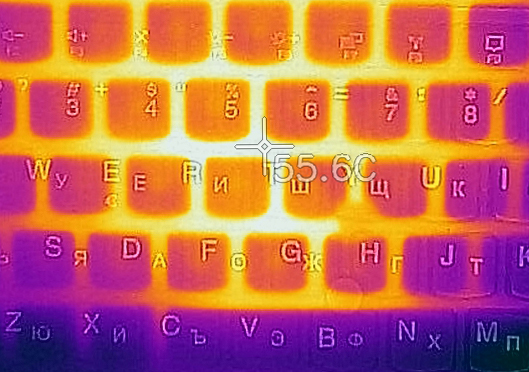
Verdict
We were generally satisfied with what we saw in the ThinkPad X13 Yoga. The build quality is decent and uses premium materials like Magnesium, Carbon fiber, and glass fiber (infused into plastics). Also, the laptop features one of the best keyboards for a convertible, but if we have to be honest, this is nothing more than we expected.
If you are frequently on the go – something extremely possible, if you have interest in this notebook, nonetheless, you will find the battery life able to last you for an entire 8-hour workday. In our tests, we got 11 hours and 40 minutes of Web browsing and 11 hours and a half of video playback. Keep in mind these tests are rather light, and a heavier load will result in shorter battery life.
Lenovo ThinkPad X13 Yoga’s IPS panel (Innolux N133HCE-EP2) has a Full HD resolution, a good contrast ratio, and comfortable viewing angles. It also covers 98% of the sRGB color gamut and its backlight doesn’t flicker above 78 nits (below that the frequency is very high and hardly detectable). Moreover, this unit has a very high color accuracy, especially with our Gaming and Web design profile, which is excellent for Web designers, e-commerce retailers, and presenters.
However, nobody expects a laptop without drawbacks. The first one would be the performance. Indeed, it is not bad, but if we take a look at it two years prior, the Kaby Lake-R processors produced pretty much the same results. And now the Tiger Lake processors provide a big step in performance. Not to mention AMD’s options right now.
Next, there is the soldered memory which comes in configurations of 8GB of 16GB of DDR4 RAM. To be honest, the chances are high you won’t be needing more than 16GB on such a machine, but it is good to know you can pay less initially, and upgrade it by yourself later on.
To finish on a good note, this is a very secure convertible, that has dual-biometric authentication, thanks to the fingerprint reader and the IR face recognition sensor. Also, the stylus works well (not as well as that of the ASUS ZenBook Flip S UX371), but it is not really comfortable for long periods of use, due to the small size.
Not in the last place, you have one of the widest I/O selections on a convertible, which includes a Thunderbolt 3 connector and a MicroSD card reader. Honestly, it would be a great purchase for people that know what to do. But keep in mind it is a bit pricey.
Pros
- Thin and light industrial design, featuring premium materials
- Covers 98% of sRGB colors and has a great color accuracy when our Gaming and Web design profile is present (Innolux N133HCE-EP2)
- Decent battery life
- Thunderbolt 3.0 port, a MicroSD card reader, and an optional LTE card slot
- Supports PCIe x4 M.2 SSDs and Wi-Fi 6
- Doesn’t use aggressive PWM for brightness adjustment (SHP14D2)
- IR face recognition and fingerprint reader
- Has an included stylus
Cons
- A bit pricey
- Memory is soldered to the motherboard
- Gets very warm under heavy load
You can check the prices and configurations in our Specs System: https://laptopmedia.com/series/lenovo-thinkpad-x13-yoga-gen-1/
